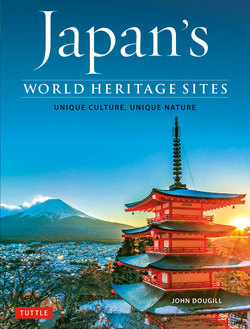Читать книгу Japan's World Heritage Sites - John Dougill - Страница 15
На сайте Литреса книга снята с продажи.
ОглавлениеKINKAKU-JI
THE TEMPLE OF THE GOLDEN PAVILION
KINKAKU-JI AT A GLANCE
FEATURES Zen temple with pavilion and pond garden. Formal name Rokuon-ji (Deer Garden Temple).
ACCESS From Kyoto JR stn, bus 101/205 (40–50 mins) to Kinkakuji-michi bus stop, then 5 mins walk or subway line to Kitaoji stn and 10 mins taxi ride.
PRACTICALITIES 9.00–17.00. ¥400. Temple tel. (075) 461-0013. Allow about 1 hour to visit.
DATELINE
1397—Founded by Ashikaga Yoshimitsu
1477—Golden Pavilion survives Onin War
1950—Pavilion burnt down
1955—Recreation completed
Kinkaku-ji is one of Japan’s iconic images, and the silhouette of its golden pavilion is famous the world over. Many are surprised to learn that it is part of a functioning Zen temple, though not those familiar with Mishima’s Temple of the Golden Pavilion (1956). The novel is based on a real-life incident when a novice monk burnt down the pavilion, and the present building is a painstaking reconstruction, completed in 1955. Now it is a must-see tourist sight whose radiant beauty is reflected in the pond in front of it.
The temple’s origins lie with a powerful shogun, Ashikaga Yoshimitsu (1358–1408), the third of his family to hold power. He took early retirement in order to pursue the arts, and in 1397 transformed a villa on the northern hills into an expansive estate which included a palace and the Golden Pavilion. Under his patronage, artists flourished, and the so-called Kitayama (Northern Hills) Culture developed in which potters, swordsmiths and other craftsmen produced goods of superlative quality (Noh was also first created at this time).
At his death, Yoshimitsu willed that the estate be turned into a Zen temple, but during the Onin War (1467–77) it was almost entirely wiped out—all except the Golden Pavilion. The three-storey structure is unusual in combining three distinct styles into a harmonious whole. The first floor is in the aristocratic style of the Heian Period, known as shinden-zukuri, and has a viewing area with verandas, unpainted wood and white plaster. When its shutters are opened, the room displays statues of Buddha and of Yoshimitsu, faintly visible from across the pond.
Kinkaku-ji’s pond garden, originally filled with lotus plants, was intended to evoke a Buddhist paradise on the other side of the watery divide.
The first floor of the Golden Pavilion comprises a reception area in the style of palace architecture. The second floor, for meetings, is in the samurai house style, while the third is in the Zen style with bell-shaped windows.
The second floor and third floors, intended to be more religious in orientation, reflect samurai and Zen styles. On the second floor is a Buddha Hall and shrine to Kannon, while on the third floor, gilded on the inside as well as the outside, are housed relics of the Buddha.
In contrast to the plain wood of the first floor, the upper floors are lacquered and covered in gold leaf, the golden glow of which was thought to be spiritually purifying. (The effect was intensified by a 1984 restoration in which thicker gold leaf was added.)
Winter snow sets off the lacquered gold leaf of the pavilion’s upper storeys, which stand in contrast to the plain wood of the first floor.
The shingled roof of the building has a pyramid form, at the top of which is a bronze phoenix, appropriately for a building now risen from the flames. The original statue of the bird survived, since it was away being repaired during the conflagration. The reflection of the building in the Mirror Pond conveys a sense of unreality, as if standing in another world, and the overall beauty of the scene is intended to suggest the Buddhist paradise.
The Muromachi Period (1333–1573) was a high point for Japanese garden design, and this is a classic example of the dynamic stroll garden, in which different perspectives open up as the visitor moves around. The ‘borrowed scenery’ of Mt Kinugasa is used to extend the dimensional depth of the scene, and there are carefully placed focal points. At the back of the pavilion is a dock for a small boat, on which guests would once have been entertained by a leisurely tour as the host pointed out places of beauty or references to scenes from literature. There are ten small islands in all, the largest of which represents Japan. Four stones in a straight line near the pavilion suggest sailboats anchored on their way to the Isle of Eternal Life in Chinese mythology.
Within the temple grounds is a pond whose small pagoda is dedicated to the White Dragon controlling the water supply.
From the pond, the route leads visitors past the former living quarters of the head priest, not open to the public, and past the Anmintaku Pond where coins are tossed towards the statues for good luck. The Sekkatei Teahouse, added during the Edo Period, contains a celebrated pillar made from the nandin tree. Outside the exit of the compound is a temple hall housing a Fudo-myo statue, supposedly carved by the legendary Kukai, as well as places to enjoy whipped green tea (matcha). It makes a fitting way to round off a visit to this glittering gem of Japanese aesthetics, allowing one to reflect on the beauty within and the terrible ordeal that it has overcome.
The third floor of the pavilion, with its views of nearby Mt Kinugasa, offered space for tea drinking and meditative contemplation. It once held statues of Amida and twenty-five bodhisattvas.
